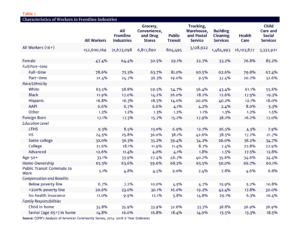
A recent report on Basic Demographic Profile of Workers in U.S. Frontline Industries by the Center for Economic and Policy Research (CEPR) looks at six broad industries, employing grocery store clerks, warehouse workers, bus drivers, and care workers – including nurses, care workers at child care and residential care facilities, as well as household and community service workers.
Based on CEPR’s analysis using the American Community Survey (2014 – 2018), over half of all essential workers in the industries examined are employed in care services. More than a third of these workers are over the age of 50; and before the pandemic, nearly a quarter were living in low-income households and about half lived with a child or a senior at home.

At the national level, women workers are overrepresented in frontline industries. About one-half of all workers are women, but nearly two-thirds (64.4 percent) of frontline workers are women. Women are particularly overrepresented in care-work related industries – Healthcare (76.8 percent of workers) and Child Care and Social Services (85.2 percent).
Black and Hispanic workers, as well as other people of color are also overrepresented in many frontline industries occupations. Black workers are most overrepresented in Child Care and Social Services (19.3 percent of workers). Hispanic workers are especially overrepresented in Building Cleaning Services (40.2 percent). Immigrants are also overrepresented in Building Cleaning Services and in many frontline occupations in other frontline industries.
The report calls on U.S. congress to include important protections for frontline workers in its response to COVID-19 – including comprehensive health-care insurance, paid sick and family leave, free child-care, student loan relief and other labor protections related to workers’ health, safety and immigration status.
About the report:
A Basic Demographic Profile of Workers in Frontline Industries. Hye Jin Rho, Hayley Brown, and Shawn Fremstad. Center for Economic and Policy Research. April 2020.
